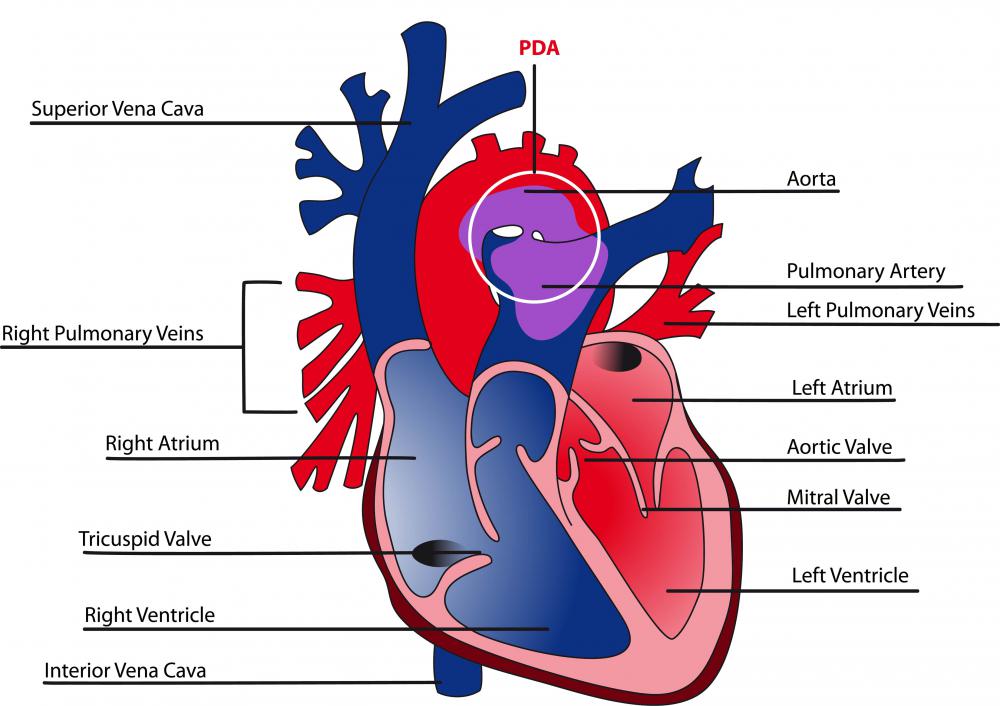At TheHealthBoard, we're committed to delivering accurate, trustworthy information. Our expert-authored content is rigorously fact-checked and sourced from credible authorities. Discover how we uphold the highest standards in providing you with reliable knowledge.
How does the Heart Work?
The heart is a large muscle that works continuously, pumping blood throughout the entire body through muscular contractions. Like the central mechanism of a large machine, a problem with this organ can affect the function of nearly every part of the body. Understanding how this amazing part of the body works can help give insight into the wondrous abilities of muscular machinery.
The heart is primarily divided into four chambers: the upper section has the left and right atria, while the lower is divided into the left and right ventricles. The right atrium and ventricle mostly take care of just one specific organ, doing the majority of their work with the lungs. The left side of the organ, on the other hand, is responsible for pumping blood to the entire rest of the body.

The means that the heart uses for distributing blood is known as the circulatory system. This is a network of tubes that stretches throughout the body like a road system, providing various on ramps, off ramps, and interchanges for blood to move around. The circulatory system is divided into blood vessels, such as capillaries and arteries, that carry blood to the organs and tissues, and venules and veins, which carry blood away back to the organ. Together with the lungs and heart, this network creates one of the most vital functions of the body: the circulation of blood.

Not only is the heart responsible for getting blood where it is going, it also plays an important part in supplying blood with nutrients and oxygen for the organs, much like sending someone off to school with a packed lunch. On the right side of the organ, oxygen-deprived blood enters through two large veins and is pushed into the lungs by the right ventricle. After being loaded with oxygen in the lungs, the now oxygenated blood flows into the left side and is sent off to the rest of the body via the aorta, which is the largest blood vessel in the body.

Many people aren't aware that their hearts are actually electrical organs. In order for the heart to “beat,” which creates the pumping motion that moves blood around, an electrical impulse must be sent to the muscle. This impulse is created by a cluster of cells in the right atrium, known as the sinotrial node. Disruptions in the function of this area can result in an irregular heartbeat, which sometimes leads people to have an artificial electronic device, known as a pacemaker, installed to regulate the heartbeat.
AS FEATURED ON:
AS FEATURED ON:













Discussion Comments
@Tufenkian925
The heart is regulated by the unconscious mind, but most of the unconscious mind is at the base of the brain, and is held in the part of our mind that is least evolved. Animals use this "instinctual" part of the brain to do most of what they do to survive. There is no real "conscious" or intuitive function in them that can compare to our own conscious mind.
@Leonidas226
I naturally think of our societal association of the heart with love, the soul, and other involuntary "deeper" feelings. This is probably from the ancient and Biblical traditions, which saw the heart as the source of feelings. Today we know that it is connected with our involuntary and unconscious feelings at a biological level as well.
Problems with the heart are particularly alarming because they affect the entire body and can result in death very quickly. The whole body depends on the brain for intuition and the heart for consistency. This makes both of them the two most important organs.
The heart is an involuntary muscle. This is important, because we are unable to consciously stop or start the heart from working. It is always going and sustains us even when we are asleep, giving us a regular source of energy in terms of the blood flow and energy.
Post your comments